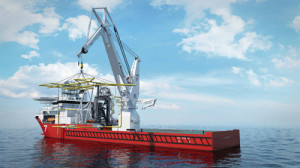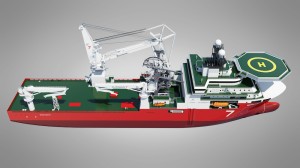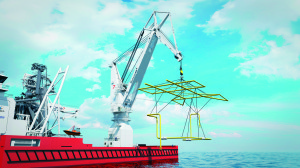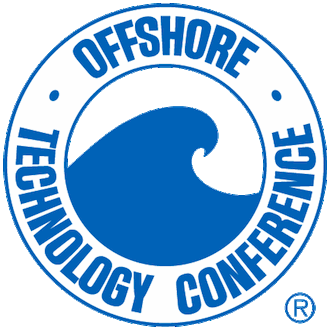Subsea 7 Construction Vessel Seven Arctic with Huisman Innovation

By John Gauldie
Subsea 7’s new flexlay construction vessel Seven Arctic will open up new possibilities for deepwater subsea architecture, says David Mair, Subsea 7’s Vice President of Business Development. The vessel’s big draw card is Huisman’s innovative new knuckle boom; “the best crane of this capacity on the market,” according to Subsea 7’s Dr Stuart N. Smith, Vice President of Technology and Asset Development.
Subsea architecture boundaries are expanding, structural lifts are heavier and deeper, and spoolpieces are longer and more complicated to handle. Contractors need to install heavier and longer umbilicals and cables, farther from existing infrastructure. This is the market where Mr Mair believes Seven Arctic will fill a capability gap and meet the twin goals of cost effectiveness and increasing operational efficiency.
“We expect subsea production to be on a par with traditional platform production over the next 15 years or so,” he noted. “And if that’s the case then we think there’s a tremendous opportunity for our particular services.”
Workhorses of the Fleet

Subsea 7’s fleet of over 40 vessels has a wide range of crane capabilities. The fleet already has around 15 vessels in the flexlay/construction category, also known as Heavy Construction Vessels (HCV). The HCVs are “the workhorses of the fleet”, Dr Smith explained, combining capability and versatility.
This year will see the delivery of Seven Waves, another flexlay construction vessel, which features one of the industry standards in subsea lifting – the Huisman 400t Offshore Mast Crane (OMC). This very effective crane combines big outreach with low centre of gravity for good stability, enabling deepwater (3,000m) lowering.
Dr Smith explained, “The Huisman 400t OMC… our clients have liked it and we’ve been looking at what’s coming next. So we’ve had that in the back of our minds and thinking what can we do better, what features can we take from other cranes around. So we thought about knuckle boom features, which are quite often useful, and we thought about wire sizes and speed and things like that.”
Knuckle Boom Advantage
Huisman had also been thinking about the next development in its subsea knuckle boom crane range. Knuckle booms are a particularly safe and efficient way of moving loads with minimal swing. In 2010 Huisman delivered the 250t subsea knuckle boom crane for Seven Pacific. Another Subsea 7 vessel, the Skandi Acergy, operates a NOV 400t knuckle boom (225t at 2,500m).
“That’s what you might call the conventional hydraulic knuckle boom crane,” Dr Smith continued. “That’s been very successful for us. We’ve done a lot of work for Statoil with that crane. And there are some features in that crane that we’ve got as opposed to the general market. The small improvements there have allowed us to win quite a lot of work from our competitors.”
Subsea Construction

The new design is a development of the Huisman Pedestal Mounted Offshore Crane using a novel, knuckling system on the main boom, which is actuated using wire ropes rather than hydraulic cylinders. The heave-compensated design maintains higher capacity functionality, while not suffering weight penalty and the associated impact on ship stability when operating conventional knuckle boom designs.
“Huisman were working on these knuckle boom cranes so we went into a period when we were working with them on a number of features, generally optimising it for our purposes,” Dr Smith said. “We thought this is the right crane for us and for our clients, and went ahead on that basis. So it’s been a very fruitful relationship with Huisman.”
Dual Fall Mode
Configured primarily for single (300t) and dual fall (600t) lifts, the crane also has subsea triple fall (900t) capability with some limitations (up to 1,000m water depths).
“For quite a lot of our work… you have your top level capability and certainly you need that for specific jobs, but for a variety of other jobs you’re looking more at our mid capability,” Dr Smith explained. “So our 900t crane we see being used a lot in its various other modes. For a lot of lifts the 600t mode will be most appropriate.”
In dual fall mode the crane will have the capability to overboard 400t and deploy to 2,000m, or 500t to about 1,500m. This will cover modules, manifolds and templates weighing in the 300-500t range, where Subsea 7’s current HCVs are at the limit of their capacity.
“Around the 450t mark at 1,500m is going to cover quite a lot of the subsea processing modules that some of our clients are thinking about at the moment.”
Over 6,000m of crane main hoist wire will be installed to enable almost 300t to be lowered to 3,000m. A special hook system and wire handling system ensure that wire twisting is prevented. Wire diameter has been kept to 109mm to avoid the heating and subsequent degradation problems associated with heave compensation on larger diameter wires.
More Workability

Many operations will not need such capacity. In single fall mode, the crane can move equipment from every corner of the large 2,600m² deck, reducing the need for deploying skidding systems, and maximising the vessel’s operational time.
Two additional cranes ensure efficient deck operations and allow a number of lines lowered simultaneously to the seabed for complex or simultaneous operations. For installing flexible pipe/umbilicals/power cables, Seven Arctic features a Huisman vertical pipelay system (325t single tensioner, 360t A&R) and Maats Tech will deliver the 7,000mt underdeck carousel – considerably larger than any of Subsea 7’s other vessels.
Mr Mair: “We anticipate that there’s going to be greater distances between hosts and stepouts. To that end we see power cables of fairly significant lengths. We see more on the umbilical side. We’re expecting fairly substantial use of that kind of capacity.”
Arctic to Angola
With ice-strengthening and winterisation features, Dr Smith confirmed that the Seven Arctic would be particularly well-suited to the harsh environment of the far North for an expanded operating season.
However, despite her name, Seven Arctic is designed for global operations. Mr Mair highlighted the range of opportunities for Seven Arctic. “We have significant opportunities emerging in and around Australia, and Indonesia, again principally deepwater, and again West Africa… The Gulf of Mexico, that’s starting to open up for us too, as drilling commences post Macondo.”
Ship Construction
Hyundai Heavy Industries (HHI) has nearly completed detailed design of Seven Arctic’s preliminary VS 4285 HCV design by Wärtsilä Ship Design. Steel-cutting is scheduled for July/August this year. Final assembly of Seven Arctic’s crane will probably take place at Huisman’s China facility then shipped to Korea for integration. Delivery into the fleet is scheduled for 2016.
With the Seven Arctic, Dr Smith believes offshore developers can further push the boundaries of field development. “We can deploy heavier loads in greater water depths, and we can install and lay greater quantities of flexible pipe and umbilicals at greater water depths. We can store more project equipment than our other vessels.”
Mr Mair concluded, “We do have real confidence in [Seven Arctic’s] place in the market. We see that’s where the market is heading – real challenges in deeper water and difficult environmental conditions.”
[Editor’s note: This article appeared in Offshore Industry Volume 7 Issue 1]
SPECS
Principal Particulars
- Length o.a. 162.3m
- Breadth 32.0m
- Depth 13.5m
- Draught 8.5m
- Deadweight 14,000t
- Speed 15 knots
- Accommodation 132
Machinery & Propulsion
- Installed Power 25.3MW
- Aft Propulsion 2x 8MW shafts; 2x 2.6MW tunnel
- Fwd Propulsion 2x 2.3MW retractable azimuth; 2x 2.6MW tunnel







